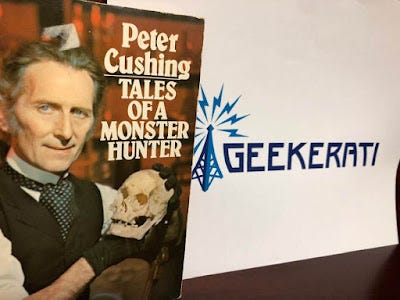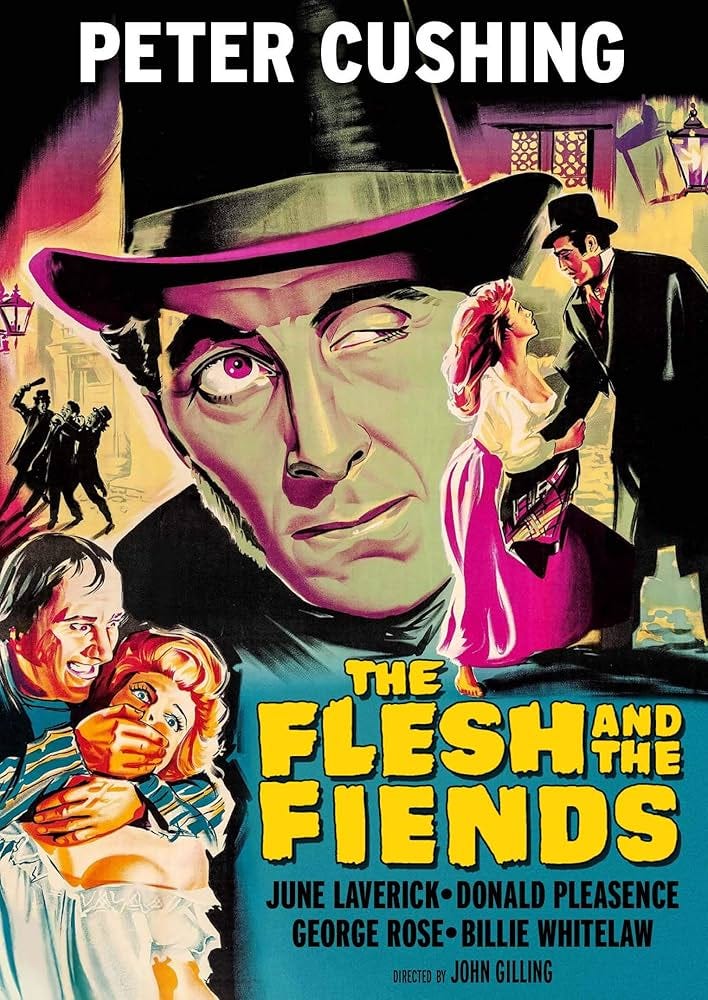Peter Cushing Horror Anthology Editor?
A Happy Belated Birthday to the "Editor" of My Personal "Appendix Hammer"

In gushing over the anniversary of Vincent Price’s death the other day, I completely forgot to acknowledge the birthday of one of the greatest actors who ever lived. Peter Cushing was born on May 26, 1913 and has starred in more of my favorite films and television shows than I can easily count. From High Adventure to Horror and from Science Fiction to Farce and Drama, Cushing had a remarkable career. He also was featured as the “editor” of a very interesting collection of horror stories.
As you might imagine, the Geekerati library is filled with volumes containing tales of Sword & Sorcery, Sword & Planet, Science Fiction, Fantasy, and not a small amount of Horror. One of the books I am proudest to have in the library is the 1978 paperback printing of Peter Cushing's Tales of a Monster Hunter.
As I mentioned above, Cushing holds a special place in my geekiest of hearts. Not only did he star in several Hammer Studios Horror films, some of the greatest horror films ever produced, but he was himself a bit of a gaming geek. He collected, painted, and played miniatures wargames. In the British Pathé archival short below, you can see his genuine joy. I can’t quite tell if he has any copies of the British Model Soldier Society’s Bulletin on his shelves, but I wouldn’t be surprised if he did. This video was filmed in 1956, which lines up with the publication of Tony Bath’s medieval rules in the Bulletin. I’ve played a couple of games using H.G. Well’s rules from Little Wars, which Cushing features in this short, but I can’t help but think he would find the advances in wargaming game mechanics of the era intriguing.
As much as I want to believe that this collection of horror stories was selected by Mr. Cushing himself and reflects his personal taste, it is unlikely that the volume was entirely edited by Mr. Cushing. The copyright lists both him and Peter Haining and Cushing's autobiographical preface is written in third person. I would think it odd if Mr. Cushing referred to himself in the third person, but stranger things have happened. The volume also came out around a time when publishers were releasing collections of short stories “edited” by pop culture figures. Another example of this kind of publication is Peter Davison’s Book of Alien Monsters, which states that it was edited by Peter Davison but was likely edited by Richard Evans.
Peter Haining was an anthologist of horror tales who had a number of volumes printed in the late 70s and early 80s. One of these volumes is the very interesting Sword & Sorcery paperback The Barbarian Swordsmen under the pseudonym Sean Richards, which contains stories by Robert E. Howard, Lord Dunsany, C.L. Moore, and Fritz Leiber.
Setting aside my belief that Cushing wasn’t necessarily the primary editor of the book, there is reason to think that Cushing provided feedback to the selections. Even if he didn't the stories collected in the anthology pair nicely with a Cushing/Hammer Films marathon and are a fitting collection of Cushing adjacent tales if not his own selections.
Here is a brief overview of the contents of the book.
How I Became a Monster Hunter by "Peter Cushing" is a biographical essay that gives a very good overview of Cushing's acting career and has some nice quotations from Cushing himself.
A Masked Ball by Alexandre Dumas is a very short story that is included in the book because of Cushing's very small role in James Whale’s film version of The Man in the Iron Mask. Like all the stories in this volume, there is some connection between the tale and Cushing's career. In this case, it’s not a direct connection as Cushing’s role is small in that film. Then again, so too is the length of this story. James Whale was famously the director of Frankenstein and The Bride of Frankenstein, so we have another connection to the tale. Elsa Lanchester, who stars as the Bride in The Bride of Frankenstein, had wonderful and varied career that includes her iconic performance as Aunt Queenie in Bell, Book and Candle.
The Mortal Immortal by Mary Shelley is a reminder that the creator of modern science fiction wrote more than just Frankenstein. Given that much of Cushing's career was spent portraying various versions of Dr. Frankenstein, a Shelley story is a must and it is always nice to see a deep cut rather than an excerpt from a more well known work. As a society we often focus too narrowly on the works of past writers and leave out the rest of their career. In the case of Robert E Howard, we often focus on his Conan stories to our own detriment. In the case of Shelley, by focusing on Frankenstein we miss out on other stories that can touch upon our own times. While ChatGPT and other “advances” keep Frankenstein relevant and remind us how mankind’s creations can become threats, I found that her novel The Last Man was particularly resonant for me during the Covid pandemic. Mary Shelley didn’t produce a library worth of material, but she was far from a one hit wonder.
Dracula's Guest by Bram Stoker is an episode that, according to the editor’s introduction in Tales, was excluded from the famous novel due space restrictions imposed on Stoker by his editor. Cushing's connection to Dracula in his portrayal of Van Helsing is well known and it has been argued in D&D geek circles that Van Helsing is one of the inspirations for the Cleric class in D&D.
In the Footsteps of the Abominable Snowman by Joseh Nesvadba is a Yeti tale that is included due to Cushing's performance in The Abominable Snowman of the Himalayas. This is not the story that inspired the film, which was a teleplay, but it bears some similarities in tone to the underappreciated film.
The Ring of Thoth by Sir Arthur Conan Doyle connects with Cushing's career in two ways. Cushing played Sherlock Holmes on the big screen in Hound of the Baskervilles and he also starred in a Hammer version of the Mummy story. "The Ring of Thoth" isn't a Holmes tale, but it is a Mummy yarn and one that makes me wonder if Robert E. Howard had a copy on his shelf (the answer is YES!). After all, Howard's villain Thoth-Amon sought his Serpent Ring of Set in the first Conan tale and there are similarities of tone here.
The Gorgon by Gertrude Bacon is a late Victorian tale published in The Strand that makes use of the Greek legend of the Gorgon. Cushing had starred as the villain in the 1964 Hammer film The Gorgon, even though it shares many similarities to the story the Encyclopedia of Hammer Films states that the film’s screenplay was based on a story submitted to Hammer by J. Llewellyn Divine, and there are few enough tales of the creature that this makes a nice addition to the book. The Hammer film is much better than its effects and is one of a list of Hammer productions I wish could be remade with the same caliber of performances but with modern effects.
The Man Who Collected Poe by Robert Bloch is the first tale in the volume that Cushing actually performed in a direct adaptation of the story during his career. The story is adapted in the film Torture Garden (1967) where Cushing plays the "bibliophile."
The Ghoul of Golders Green by Michael Arlen (published in 1925 and public domain in the US) is a story that was published in the collection May Fair and The Mammoth Book of Thrillers, Ghosts, & Mysteries. This is a classic horror collection that Dr. Rebekah King lovingly calls “The Bat Book.” Dr. King has created a regular feature on her Substack Dr King's Curiosities where she reads stories from the Bat Book that has been added to my rotation of “drive home listens.”
This particular story is connected thematically to Cushing's career in that he starred in a couple of ghoulishly themed films and a starred in a number of tales that have a “twist” ending. Of his “ghoulish” roles, the first is The Flesh and the Fiends (aka The Fiendish Ghouls) which includes killings as a backdrop, though I don’t wish to spoil the very meta ending of Golders Green. Cushing’s later film, The Ghoul in 1974, which was based on an original screenplay by John Elder and features a ghoul more along the lines of a D&D ghoul.
One of the interesting things about The Ghoul of Golders Street is that it contains a tale within a tale within the tale. The conceit is that a friend is telling you a story told to him by one Mr. Trevor. That retelling contains another story within it and with the ending…well you will either like it or not.
There Shall Be No Darkness by James Blish is the final tale in the volume and it is a great story to finish with as it served as the basis for the film The Beast Must Die. A while back a Vulture article recommended watching this film before or after watching Knives Out. If you've ever played the game Werewolf, you really should check this movie out as it provides the audience with a short "Werewolf Break" in order for the audience to guess which character is the werewolf. It's great fun. In the aftermath of Glass Onion, I’d argue that the second Rian Johnson detective mystery shares even more with The Beast Must Die than Knives Out. To this day, I still think of Calvin Lockhart’s character, Tom Newcliffe, as an alternate universe version of Marvel’s Blade. Watch the film and see why. It’s a film I watch every Halloween season.




I remember being incredibly surprised by his appearing in Top Secret. It was a great cameo role.
He along with Christopher Lee is one of the Hammer greats.